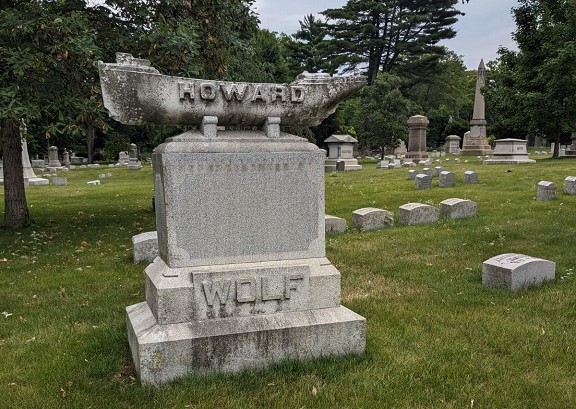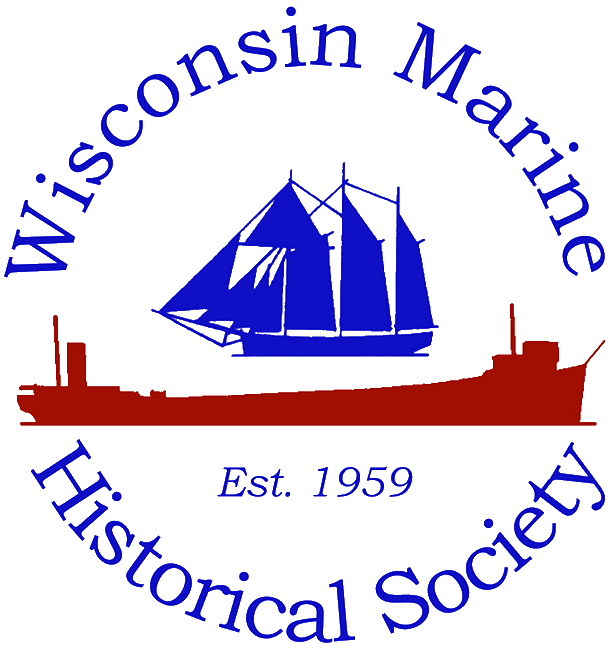
MARITIME HEROES OF FOREST HOME CEMETERY
By James Heinz
Most of the time I write stories about shipwrecks that lie under the water. I know of two shipwrecks that now lie under the land, and this story will be about Milwaukee maritime heroes who also lie under the earth, including several that I have written about before.
Recently I joined a tour of the graves of these heroes, located in Forest Home cemetery. The tour was conducted by my friend Mark Kuehn, former curator of the North Point Lighthouse museum. Mark said that his uncle lived in the North Point lighthouse as a member of the Coast Guard from 1958 to 1961.
Mark started the tour at the cemetery, which was the first crematorium in Wisconsin. It was the site where the body of Edward Gifford Crosby was cremated. Crosby was a Milwaukee ship owner who was reputed to be unwilling to buy enough lifeboats for everyone on his ships.
Crosby died on the Titanic, supposedly because he could not find a lifeboat. His body was recovered and cremated at Forest Home, and he and his wife and daughter, who survived the Titanic, are buried with him in Graceland Cemetery in Milwaukee. I detailed Crosby’s life and death and the post mortem journey of his and his family’s remains in a previous blog article.
Next we came to the side by side burial plots for the Wolf and Davidson families. These are the same Wolf and Davidson families that ran a famous Milwaukee shipyard of the same name. Their original shipyard was on Jones Island. When that one was washed away, they built another one “in a swamp” where the UWM Great Lakes Water Institute stands today.
One of the grave monuments has a carved stone model of a Great Lakes bulk carrier with the word “HOWARD” carved on the front of it. Mark explained that this is a monument to Howard Wolf. At age 16 Howard had been sent “to learn the business” and died when he fell into the hold of a ship. The carved stone model is a model of the ship he died on.
We viewed the grave of Frederick Pabst. Although remembered for his namesake beer, Fred Pabst started out as a Great Lakes ship captain. According to Mark, in 1863 Pabst and his ship were caught in a storm and wrecked on the beach at Whitefish Bay. After that the allure of the sea lost much of its allure, and he came ashore and took over his father in law’s operation. the Jacob Best’s brewery.
We next came to the grave of Ben Froemming, who I had profiled in a previous blog article. Ben was a cement contractor who somehow got a contract to build ships during World War II. He established a shipyard on the KK River at 1st Street, where a marina stands today. Ben built frigates, tug boats, and cargo vessels. The last vessel he built was named after him. The half models of the ships he built are in the collection of the WMHS.
The tour then came to the final resting place of a name famous to all lovers of Great Lakes maritime history: Edmund Fitzgerald. He was the namesake of the most famous shipwreck in Great Lakes history, and the shipwreck that is the second most famous to most Americans after the TITANIC: the EDMUND FITZGERALD.
It is said that Edmund did not want a ship named after him. Legend says that when he stepped out of a board of directors meeting for a moment, the board voted to name it after him anyway. Mark told us that when the “Big Fitz” was christened, the champagne bottle did not break three times. This was thought by superstitious sailors to be a bad omen. Eighteen years later the prophecy was fulfilled.
Mark then led us to the grave of legendary Milwaukee underwater explorer Max Gene Nohl. Max was the Jacques Cousteau of his day. He made innovations in underwater equipment, did underwater filming for the movies, set a deep diving record of 400 feet off Port Washington, worked on decompression tables for divers, and helped found the Divers Equipment and Supply Company (DESCO) which still exists. His sister was the famous Fox Point artist Mary Nohl.
Max is best known to divers today as the man who tried twice to salvage the wreck of the Dutch freighter PRINS WILLEM V, which sank in 1954 after a collision 3 miles off Milwaukee. Fortunately for divers, he failed and today the PRINS is regarded as one of the best dive sites in America. I did my first and last dives on “the Willie”.
Although I had previously profiled the lives of some of the people whose graves we visited, the next grave was of a true hero of the Lakes who I hope to chronicle in the future. Nels Peterson was a member of the U.S. Lifesaving Service. Mark said he was involved in the 1873 rescue of two men from a Great Lakes storm.
The men had been digging the water intake tunnel which leads to Milwaukee’s North Point water tower when a storm washed away the wooden vertical shaft house perched atop none other than Milwaukee’s famous “Love Island”. The storm had washed the shaft house away and killed 15 men already. Stay tuned to this blog for the full story in the near future.
The final grave was that of the legendary North Point lighthouse keeper Georgia Stebbins, whose life I have chronicled in a previous post. It was Georgia who spotted the three men stranded on Love Island in 1873 from the top of the lighthouse and summoned the aid that led to Nels Peterson’s rescue.
One post mortem cemetery mystery our readers may be able to solve is that of the Wellauer family. Although not on Mark’s tour, the family grave plot features a statue of an angel holding an anchor. If you know what connection to maritime history this monument may have, please contact the WMHS.
To read some of the blogs mentioned above, check out our website listing at: https://wmhs.org/blog/
Photos provided by James Heinz
Photo at top of the page: Wolf Family Marker featuring the bulk carrier for Howard Wolf
Other photos:
Crosby Marker at Graceland Cemetery in Milwaukee
Wolf & Davidson Shipyard in Milwaukee
Froemming Family Marker with Mark Kuehn
Bernhard “Ben” Froemming’s Marker
Edmund Fitzgerald Marker
Max Nohl Marker
Nels Peterson Marker
Georgia Stebbins Marker
Jacob Wellauer Family Marker
____________________________________
James Heinz is the Wisconsin Marine Historical Society’s acquisitions director. He became interested in maritime history as a kid watching Jacques Cousteau’s adventures on TV. He was a Great Lakes wreck diver until three episodes of the bends forced him to retire from diving. He was a University of Wisconsin – Milwaukee police officer for thirty years. He regularly flies either a Cessna 152 or 172.
